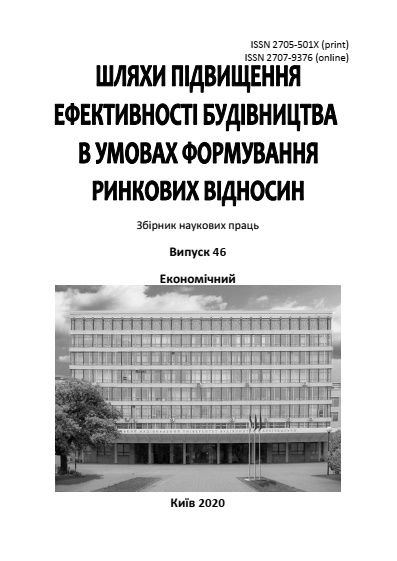Discriminant analysis during the financial security benchmarking of PJSC "Kompleksne pidpryiemstvo shyrokoprofilnoho budivnytstva-2"
DOI:
https://doi.org/10.32347/2707-501X.2020.46.3-15Keywords:
discriminant model, benchmarking, financial condition of the enterprise, financial indicators, concentration coefficient of equity, return on sales - ROS, coverage ratio, construction enterprises, analysis of competitorsAbstract
The authors in the research article consider benchmarking as an effective management tool. This method usually is used in marketing, marketing research, but benchmarking can also be used to increase the economic efficiency of financial management of the company. The article identifies the principles and peculiarities of benchmarking analysis, the authors propose new stages of benchmarking on the basis of generalization of approaches of different researchers for this issue.
Researchers use methods such as cluster analysis, factor analysis, component analysis, regression analysis and discriminant analysis, because there is a need to divide the objects of research into separate groups according to the main strategic priorities.
The authors choose discriminant analysis, which was performed using MS Excel software. Benchmarking analysis of financial security was conducted on three indicators - coverage ratio (from the group of liquidity indicators), concentration coefficient of equity (from the group of financial stability indicators)and ROS (from the group of profitability indicators). The sample of competing companies was formed, consisting of 15 joint-stock companies of Kyiv region and Kyiv with the main activity - construction of residential and non-residential buildings.
Two sub-samples have been identified, each containing 4 objects: the first group includes the best companies, where the threat of financial crisis is not high, while the second group includes the worst companies with inefficient financial management. Subsamples formation criterias are the maximum and minimum of the average value of three indicators.
Efficiency of financial management, probability of financial crisis and getting of benchmarking companies in a particular group is determined according to the discriminant analysis with the help of an integrated indicator.
References
Багиев Г.Л., Аренков И.А., Соловьева Ю.Н. Бенчмаркинг как функция и инструмент предпринимательской деятельности Маркетинг и культура предпринимательства: тезисы докладов междунар. науч. конф. СПб. : СПбУЭФ, 1996. Ч 1. С. 65 – 69.
Двірко Ю.В. Проведення бенчмаркінгу торговельних підприємств споживчої кооперації. Вісник економіки транспорту і промисловості. 2012. Вип. 40. С. 232-236. Режим доступу: http://nbuv.gov.ua/UJRN/Vetp_2012_40_57
Дубодєлова А.В., Юринець О.В. Особливості та технологія внутрішнього бенчмаркінгу на підприємстві. Маркетинг і менеджмент інновацій. 2013. № 2. С. 64-73. Режим доступу: http://nbuv.gov.ua/UJRN/Mimi_2013_2_7
Захарченко В.І., Корсікова Н.М., Меркулов М.М. Інноваційний менеджмент: теорія і практика в умовах трансформації економіки: навч. посіб.; Одес. нац. ун-т ім. І.І. Мечникова, Одес. нац. акад. харч. технологій, ОНПУ. Київ : ЦУЛ, 2012. 448 с.
Навольська Н.В. Бенчмаркінг як інструмент підвищення ефективності діяльності підприємств. Причорноморські економічні студії. 2016. Вип. 6. С. 79-82. Режим доступу: http://nbuv.gov.ua/UJRN/bses_2016_6_18
Офіційна звітність учасників фондового ринку України. Режим доступу: https://smida.gov.ua/
Роїк О.М., Азарова А.О., Небава М.І. Основи стратегічного менеджменту. навчальний посібник. Вінниця: ВНТУ, 2007. 213 с.
Терещенко О.О. Фінансова діяльність суб’єктів господарювання: навч. посібник. К.: КНЕУ, 2003. 554 с.
Яровий А.Т., Страхов Є.М. Багатовимірний статистичний аналіз: начально-методичний посібник для студентів математичних та економічних фахів. Одеса: Астропринт, 2015. 132 с.
Кушнірук А. Ідентифікація внутрішніх та зовнішніх загроз системі економічної безпеки будівельних підприємств. Шляхи підвищення ефективності будівництва в умовах формування ринкових відносин, 2015. Вип. 33. 175-186.
Stetsenko S., Bolila N., Sorokina L., Tsyfra T., Molodid O. Monitoring mechanism of resilience of the anti-crisis potential system of the construction enterprise in the long-term period. Еconomics, finance and management review. 2020. №3, 31-42.
Bielienkova O., Stetsenko S., Sorokina L., Molodid O., Bolila N. System of preventive аction of construction enterprises on the basis of identification of anticrisis potential. Scientific Journal of Astana IT University №3 2020 рр. 15-27.
Гусарова Л.В., Боліла Н.В. Екологічний компонент економічної безпеки як чинник сталого розвитку підприємств будівництва. Науковий погляд: економіка та управління, 2020. №2 (68). С.121-124.
Боліла Н.В., Цифра Т.Ю., Шевченко Ю. Ефективне використання оборотних коштів будівельного підприємства як фактор економічної безпеки. Шляхи підвищення ефективності будівництва в умовах формування ринкових відносин. 2020. 44. С.174-182
Hryhorovskyi P. Ye., Stetsenko S. P., Menejljuk O. I., Khyzhniak V. O., Ryzhakova G. M.. Multiple criteria model for proving investment and construction project efficiency. Organizational and technological model engineering in the construction industry : collective monograph – Lviv-Toruń : Liha-Presб 2019. 142 р.
Bielienkova О.Yu. Antropov Yu.V. The prediction model of economic stability (based on small construction enterprises of Ukraine) European Applied Sciences. № 8. Р. 161–163.
Мігус І.П., Андрієнко В.М. Структура та основні елементи системи забезпечення економічної безпеки при управлінні безпекою праці на будівельних підприємствах // Бізнес-Інформ. 2014. № 10. С. 213-219.
Фісуненко П.А., Лаже М.В. Особливості забезпечення економічної безпеки будівельних підприємств. Шляхи підвищення ефективності будівництва в умовах формування ринкових відносин, 2015. Вип. 33. С. 156-164.
Гойко А.Ф., Сорокіна Л.В., Скакун В.А. Емпіричне оцінювання безпеки економічного розвитку підприємств будівництва: європейський аспект. Шляхи підвищення ефективності будівництва в умовах формування ринкових відносин, 2019. № 40. С.3-18.
Downloads
Published
How to Cite
Issue
Section
License

This work is licensed under a Creative Commons Attribution 4.0 International License.
Authors who publish with this journal agree to the following terms:
- Authors retain copyright and grant the journal right of first publication with the work simultaneously licensed under a Creative Commons Attribution License that allows others to share the work with an acknowledgement of the work's authorship and initial publication in this journal.
- Authors are able to enter into separate, additional contractual arrangements for the non-exclusive distribution of the journal's published version of the work (e.g., post it to an institutional repository or publish it in a book), with an acknowledgement of its initial publication in this journal.
- Authors are permitted and encouraged to post their work online (e.g., in institutional repositories or on their website) prior to and during the submission process, as it can lead to productive exchanges, as well as earlier and greater citation of published work (See The Effect of Open Access).

